[English] 日本語
 Yorodumi
Yorodumi- PDB-6x5q: Cocrystal structure of human CaMKII-alpha (CAMK2A)kinase domain a... -
+ Open data
Open data
- Basic information
Basic information
| Entry | Database: PDB / ID: 6x5q | ||||||
|---|---|---|---|---|---|---|---|
| Title | Cocrystal structure of human CaMKII-alpha (CAMK2A)kinase domain and GluA1 | ||||||
 Components Components |
| ||||||
 Keywords Keywords | TRANSFERASE / CaMKII / Kinase / Human / CAMK2A | ||||||
| Function / homology |  Function and homology information Function and homology informationActivation of AMPA receptors / peptidyl-threonine autophosphorylation / neurotransmitter receptor activity involved in regulation of postsynaptic cytosolic calcium ion concentration / calcium- and calmodulin-dependent protein kinase complex / regulation of endocannabinoid signaling pathway / axonal spine / Trafficking of GluR2-containing AMPA receptors / positive regulation of membrane potential / Ca2+/calmodulin-dependent protein kinase / cellular response to ammonium ion ...Activation of AMPA receptors / peptidyl-threonine autophosphorylation / neurotransmitter receptor activity involved in regulation of postsynaptic cytosolic calcium ion concentration / calcium- and calmodulin-dependent protein kinase complex / regulation of endocannabinoid signaling pathway / axonal spine / Trafficking of GluR2-containing AMPA receptors / positive regulation of membrane potential / Ca2+/calmodulin-dependent protein kinase / cellular response to ammonium ion / dendritic spine development / negative regulation of hydrolase activity / regulation of neurotransmitter secretion / neuron spine / myosin V binding / Synaptic adhesion-like molecules / Trafficking of AMPA receptors / Cargo concentration in the ER / response to arsenic-containing substance / positive regulation of calcium ion transport / regulation of neuron migration / calcium/calmodulin-dependent protein kinase activity / cellular response to dsRNA / glutamate receptor activity / dendritic spine membrane / long-term synaptic depression / Assembly and cell surface presentation of NMDA receptors / regulation of mitochondrial membrane permeability involved in apoptotic process / beta-2 adrenergic receptor binding / COPII-mediated vesicle transport / cellular response to peptide hormone stimulus / neuronal cell body membrane / CaMK IV-mediated phosphorylation of CREB / cellular response to amine stimulus / protein kinase A binding / spinal cord development / perisynaptic space / Phase 0 - rapid depolarisation / AMPA glutamate receptor activity / Negative regulation of NMDA receptor-mediated neuronal transmission / Unblocking of NMDA receptors, glutamate binding and activation / response to lithium ion / Ion transport by P-type ATPases / AMPA glutamate receptor complex / adenylate cyclase binding / Long-term potentiation / immunoglobulin binding / Regulation of MECP2 expression and activity / excitatory synapse / response to electrical stimulus / regulation of receptor recycling / regulation of neuronal synaptic plasticity / G-protein alpha-subunit binding / glutamate receptor binding / HSF1-dependent transactivation / long-term memory / postsynaptic density, intracellular component / positive regulation of cardiac muscle cell apoptotic process / neuronal action potential / regulation of protein localization to plasma membrane / cellular response to interferon-beta / response to fungicide / synapse assembly / Ion homeostasis / cellular response to brain-derived neurotrophic factor stimulus / glutamate-gated calcium ion channel activity / presynaptic active zone membrane / endoplasmic reticulum-Golgi intermediate compartment membrane / ligand-gated monoatomic ion channel activity involved in regulation of presynaptic membrane potential / Ras activation upon Ca2+ influx through NMDA receptor / synaptic membrane / dendritic shaft / response to ischemia / angiotensin-activated signaling pathway / response to cocaine / positive regulation of receptor signaling pathway via JAK-STAT / transmitter-gated monoatomic ion channel activity involved in regulation of postsynaptic membrane potential / synaptic transmission, glutamatergic / PDZ domain binding / cellular response to amino acid stimulus / neuromuscular junction / ER to Golgi transport vesicle membrane / RAF activation / G1/S transition of mitotic cell cycle / : / postsynaptic density membrane / recycling endosome / cerebral cortex development / modulation of chemical synaptic transmission / cellular response to type II interferon / receptor internalization / small GTPase binding / long-term synaptic potentiation / recycling endosome membrane / Interferon gamma signaling / Signaling by RAF1 mutants / Signaling by moderate kinase activity BRAF mutants / Paradoxical activation of RAF signaling by kinase inactive BRAF / Signaling downstream of RAS mutants / kinase activity Similarity search - Function | ||||||
| Biological species |  Homo sapiens (human) Homo sapiens (human) | ||||||
| Method |  X-RAY DIFFRACTION / X-RAY DIFFRACTION /  MOLECULAR REPLACEMENT / MOLECULAR REPLACEMENT /  molecular replacement / Resolution: 2.14 Å molecular replacement / Resolution: 2.14 Å | ||||||
 Authors Authors | Ozden, C. / Stratton, M.M. / Garman, S.C. | ||||||
 Citation Citation |  Journal: Cell Rep / Year: 2022 Journal: Cell Rep / Year: 2022Title: CaMKII binds both substrates and activators at the active site. Authors: Ozden, C. / Sloutsky, R. / Mitsugi, T. / Santos, N. / Agnello, E. / Gaubitz, C. / Foster, J. / Lapinskas, E. / Esposito, E.A. / Saneyoshi, T. / Kelch, B.A. / Garman, S.C. / Hayashi, Y. / Stratton, M.M. | ||||||
| History |
|
- Structure visualization
Structure visualization
| Structure viewer | Molecule:  Molmil Molmil Jmol/JSmol Jmol/JSmol |
|---|
- Downloads & links
Downloads & links
- Download
Download
| PDBx/mmCIF format |  6x5q.cif.gz 6x5q.cif.gz | 74.6 KB | Display |  PDBx/mmCIF format PDBx/mmCIF format |
|---|---|---|---|---|
| PDB format |  pdb6x5q.ent.gz pdb6x5q.ent.gz | 52 KB | Display |  PDB format PDB format |
| PDBx/mmJSON format |  6x5q.json.gz 6x5q.json.gz | Tree view |  PDBx/mmJSON format PDBx/mmJSON format | |
| Others |  Other downloads Other downloads |
-Validation report
| Summary document |  6x5q_validation.pdf.gz 6x5q_validation.pdf.gz | 437 KB | Display |  wwPDB validaton report wwPDB validaton report |
|---|---|---|---|---|
| Full document |  6x5q_full_validation.pdf.gz 6x5q_full_validation.pdf.gz | 437.2 KB | Display | |
| Data in XML |  6x5q_validation.xml.gz 6x5q_validation.xml.gz | 12.9 KB | Display | |
| Data in CIF |  6x5q_validation.cif.gz 6x5q_validation.cif.gz | 17.6 KB | Display | |
| Arichive directory |  https://data.pdbj.org/pub/pdb/validation_reports/x5/6x5q https://data.pdbj.org/pub/pdb/validation_reports/x5/6x5q ftp://data.pdbj.org/pub/pdb/validation_reports/x5/6x5q ftp://data.pdbj.org/pub/pdb/validation_reports/x5/6x5q | HTTPS FTP |
-Related structure data
| Related structure data | 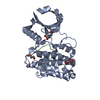 6x5gC 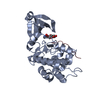 7kl0C 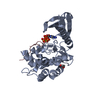 7kl1C 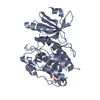 7uiqC 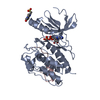 7uirC 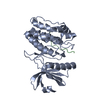 7uisC 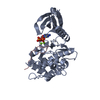 7ujpC 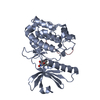 7ujqC 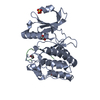 7ujrC 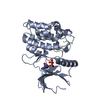 7ujsC 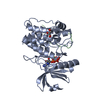 7ujtC 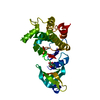 6vzkS C: citing same article ( S: Starting model for refinement |
|---|---|
| Similar structure data |
- Links
Links
- Assembly
Assembly
| Deposited unit | 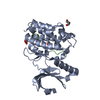
| ||||||||
|---|---|---|---|---|---|---|---|---|---|
| 1 |
| ||||||||
| Unit cell |
|
- Components
Components
| #1: Protein | Mass: 30548.086 Da / Num. of mol.: 1 / Mutation: D135N, Q223K Source method: isolated from a genetically manipulated source Source: (gene. exp.)  Homo sapiens (human) / Gene: CAMK2A, CAMKA, KIAA0968 / Production host: Homo sapiens (human) / Gene: CAMK2A, CAMKA, KIAA0968 / Production host:  References: UniProt: Q9UQM7, Ca2+/calmodulin-dependent protein kinase | ||||
|---|---|---|---|---|---|
| #2: Protein/peptide | Mass: 2323.780 Da / Num. of mol.: 1 / Source method: obtained synthetically / Source: (synth.)  Homo sapiens (human) / References: UniProt: P42261 Homo sapiens (human) / References: UniProt: P42261 | ||||
| #3: Chemical | | #4: Water | ChemComp-HOH / | Has ligand of interest | N | |
-Experimental details
-Experiment
| Experiment | Method:  X-RAY DIFFRACTION / Number of used crystals: 1 X-RAY DIFFRACTION / Number of used crystals: 1 |
|---|
- Sample preparation
Sample preparation
| Crystal | Density Matthews: 2.01 Å3/Da / Density % sol: 38.69 % |
|---|---|
| Crystal grow | Temperature: 277 K / Method: vapor diffusion, sitting drop / pH: 8 / Details: 0.1 M Tris, 28% w/v PEG 4000 |
-Data collection
| Diffraction | Mean temperature: 100 K / Ambient temp details: 100 K thorughout the collection / Serial crystal experiment: N | |||||||||||||||||||||||||||||||||||||||||||||||||||||||||||||||||||||||||||||||||||||||||||||||||||||||||||||||||||||||||||||||||||||||||||||||||||||||||||||||||||||||||||||||||||||||||||||
|---|---|---|---|---|---|---|---|---|---|---|---|---|---|---|---|---|---|---|---|---|---|---|---|---|---|---|---|---|---|---|---|---|---|---|---|---|---|---|---|---|---|---|---|---|---|---|---|---|---|---|---|---|---|---|---|---|---|---|---|---|---|---|---|---|---|---|---|---|---|---|---|---|---|---|---|---|---|---|---|---|---|---|---|---|---|---|---|---|---|---|---|---|---|---|---|---|---|---|---|---|---|---|---|---|---|---|---|---|---|---|---|---|---|---|---|---|---|---|---|---|---|---|---|---|---|---|---|---|---|---|---|---|---|---|---|---|---|---|---|---|---|---|---|---|---|---|---|---|---|---|---|---|---|---|---|---|---|---|---|---|---|---|---|---|---|---|---|---|---|---|---|---|---|---|---|---|---|---|---|---|---|---|---|---|---|---|---|---|---|---|
| Diffraction source | Source:  ROTATING ANODE / Type: RIGAKU MICROMAX-007 HF / Wavelength: 1.5418 Å ROTATING ANODE / Type: RIGAKU MICROMAX-007 HF / Wavelength: 1.5418 Å | |||||||||||||||||||||||||||||||||||||||||||||||||||||||||||||||||||||||||||||||||||||||||||||||||||||||||||||||||||||||||||||||||||||||||||||||||||||||||||||||||||||||||||||||||||||||||||||
| Detector | Type: DECTRIS PILATUS3 R 200K-A / Detector: PIXEL / Date: Jan 29, 2020 / Details: Rigaku VariMax HF | |||||||||||||||||||||||||||||||||||||||||||||||||||||||||||||||||||||||||||||||||||||||||||||||||||||||||||||||||||||||||||||||||||||||||||||||||||||||||||||||||||||||||||||||||||||||||||||
| Radiation | Protocol: SINGLE WAVELENGTH / Monochromatic (M) / Laue (L): M / Scattering type: x-ray | |||||||||||||||||||||||||||||||||||||||||||||||||||||||||||||||||||||||||||||||||||||||||||||||||||||||||||||||||||||||||||||||||||||||||||||||||||||||||||||||||||||||||||||||||||||||||||||
| Radiation wavelength | Wavelength: 1.5418 Å / Relative weight: 1 | |||||||||||||||||||||||||||||||||||||||||||||||||||||||||||||||||||||||||||||||||||||||||||||||||||||||||||||||||||||||||||||||||||||||||||||||||||||||||||||||||||||||||||||||||||||||||||||
| Reflection | Resolution: 2.1→50 Å / Num. obs: 15265 / % possible obs: 96.9 % / Redundancy: 4.9 % / Rmerge(I) obs: 0.179 / Rpim(I) all: 0.091 / Rrim(I) all: 0.202 / Χ2: 0.746 / Net I/σ(I): 3.2 | |||||||||||||||||||||||||||||||||||||||||||||||||||||||||||||||||||||||||||||||||||||||||||||||||||||||||||||||||||||||||||||||||||||||||||||||||||||||||||||||||||||||||||||||||||||||||||||
| Reflection shell | Diffraction-ID: 1
|
-Phasing
| Phasing | Method:  molecular replacement molecular replacement |
|---|
- Processing
Processing
| Software |
| ||||||||||||||||||||||||||||||||||||||||||||||||||||||||||||
|---|---|---|---|---|---|---|---|---|---|---|---|---|---|---|---|---|---|---|---|---|---|---|---|---|---|---|---|---|---|---|---|---|---|---|---|---|---|---|---|---|---|---|---|---|---|---|---|---|---|---|---|---|---|---|---|---|---|---|---|---|---|
| Refinement | Method to determine structure:  MOLECULAR REPLACEMENT MOLECULAR REPLACEMENTStarting model: 6VZK Resolution: 2.14→39.32 Å / Cor.coef. Fo:Fc: 0.936 / Cor.coef. Fo:Fc free: 0.892 / SU B: 5.435 / SU ML: 0.143 / Cross valid method: THROUGHOUT / σ(F): 0 / ESU R: 0.281 / ESU R Free: 0.206 / Stereochemistry target values: MAXIMUM LIKELIHOOD Details: HYDROGENS HAVE BEEN ADDED IN THE RIDING POSITIONS U VALUES : REFINED INDIVIDUALLY
| ||||||||||||||||||||||||||||||||||||||||||||||||||||||||||||
| Solvent computation | Ion probe radii: 0.8 Å / Shrinkage radii: 0.8 Å / VDW probe radii: 1.2 Å / Solvent model: MASK | ||||||||||||||||||||||||||||||||||||||||||||||||||||||||||||
| Displacement parameters | Biso max: 58.49 Å2 / Biso mean: 15.884 Å2 / Biso min: 1.6 Å2
| ||||||||||||||||||||||||||||||||||||||||||||||||||||||||||||
| Refinement step | Cycle: final / Resolution: 2.14→39.32 Å
| ||||||||||||||||||||||||||||||||||||||||||||||||||||||||||||
| Refine LS restraints |
| ||||||||||||||||||||||||||||||||||||||||||||||||||||||||||||
| LS refinement shell | Resolution: 2.104→2.159 Å / Rfactor Rfree error: 0 / Total num. of bins used: 20
|
 Movie
Movie Controller
Controller


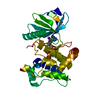



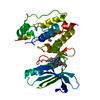
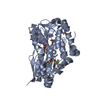




 PDBj
PDBj




















